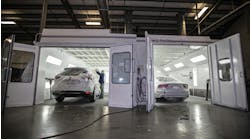CHICAGO — The average vehicle age now is more than 11 years and climbing. But even though some research from IMR shows that vehicle maintenance peaks around 11 years, it doesn’t drop off.
This partially is because vehicles are made better. But why was service down in some areas in 2012? That’s a question Wall Street wants answered, says Bret Jordan, managing director Automotive Equity Research, BB&T Capital Markets.
“2012 was a pretty lousy year,” was a quote from one retailer in a yearly wrap-up conference call, according to Jordan. The average retailer/installer comp was down 0.4 percent last year. But on balance, the tone from the Street for those selling auto parts, it was tough, and there was no solid reason, just theories.
One theory Wall Street considered focused on the combination of historically high vehicle average ages, a lack of interest in repairing vehicles and driving a vehicle until it’s “wheels fall off.” But while this is just a theory, there are some holes.
Jordan explains that there has been a good size of the 11-plus-year vehicle segment for a while, and there has not been that big of a change of the middle segment of vehicle ages. Also, consumer sentiment remains low, as does vehicle affordability. The average new car prices is just over price is $30,000, and the household income mean has declined.
“It is not as easy for a consumer to walk into a dealership and get no money down financing on a Ford Explorer today as it was in 2005,” he says.
So as Wall Street tries to figure out why vehicle maintenance dipped in 2012, it does have to keep in mind that one of the longer-term trends is the DIFM segment growing.
While the S&P 500 ultimately outperformed aftermarket retailers/installers in 2012, the first time in nearly 15 years, the trend shows that shifting back as we head out. That’s good news for 2013.
As NAPA, O’Reilly and Pep Boys reported their first quarter numbers earlier this month, they are reporting normalization and upticks so far this year. “Generally improving trends” are the takeaway from these conference calls, Jordan states.
“We believe the outlier winter allowed consumers to defer vehicle maintenance. Given the aging vehicle fleet and return to normal weather patterns… we believe likely increasing failure rates should drive industry growth in 2013,” one slide in Jordan’s presentation reported.
In the end, it’s a changing industry, but a growing one. “There will be a shift tint the service channel to do-it-for-me,” meaning regulation and demographics will drive technology and technology will force change. In the end, adapt to survive.
Subscribe to Motor Age and receive articles like this every month…absolutely free. Click here




